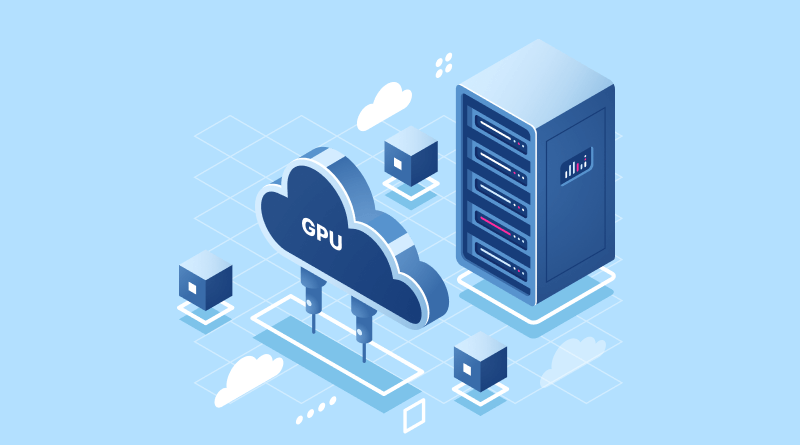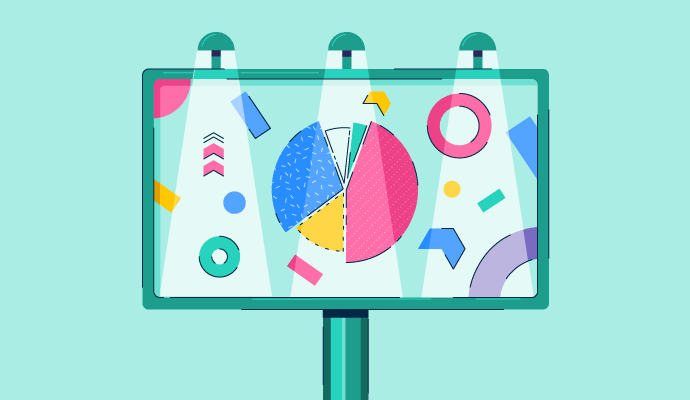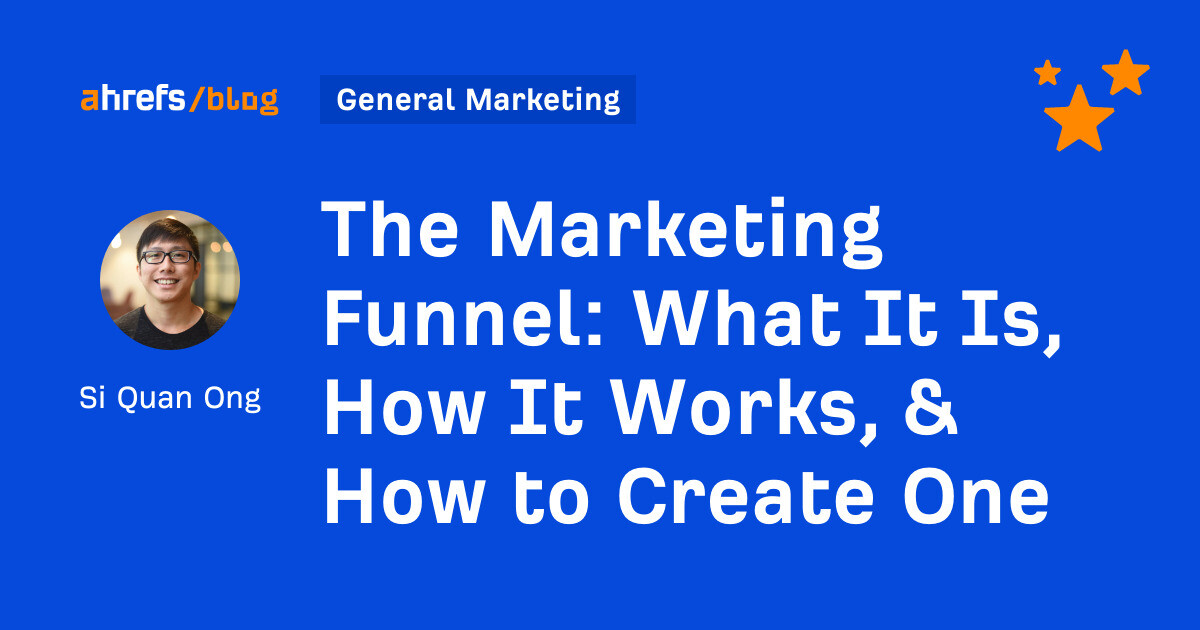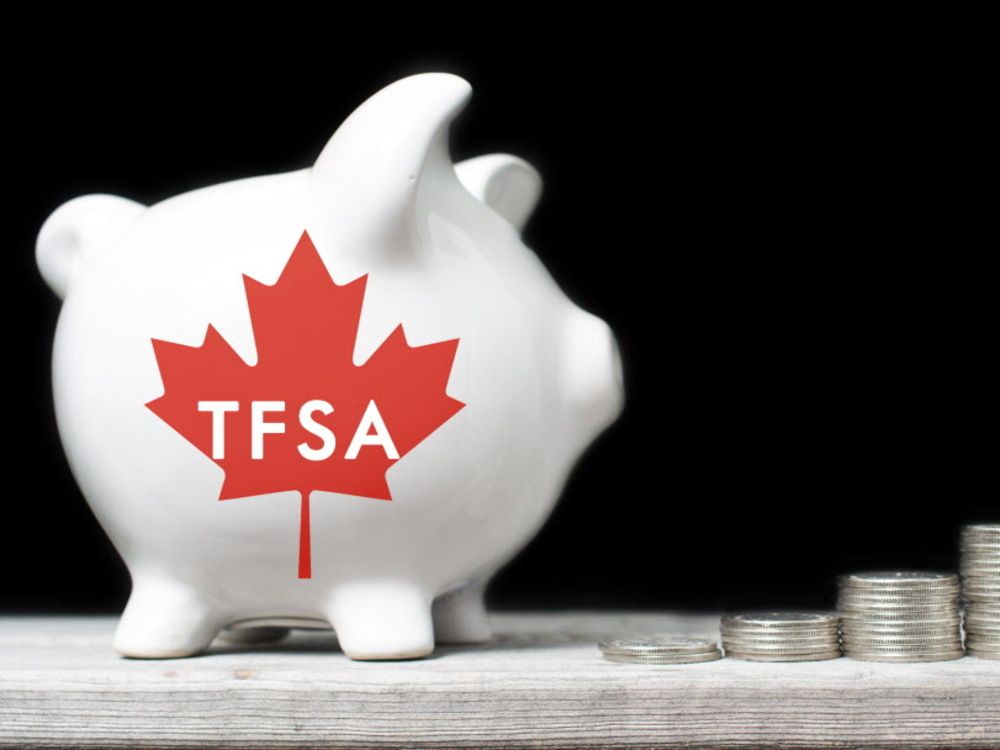Knowing how a marketing funnel works can help you diagnose problems and improve your marketing strategy.
In this guide, I’ll show you everything you need to know about marketing funnels.
Let’s get started.
A marketing funnel illustrates the buyer’s journey. It shows how people go from first learning about your brand to becoming customers.
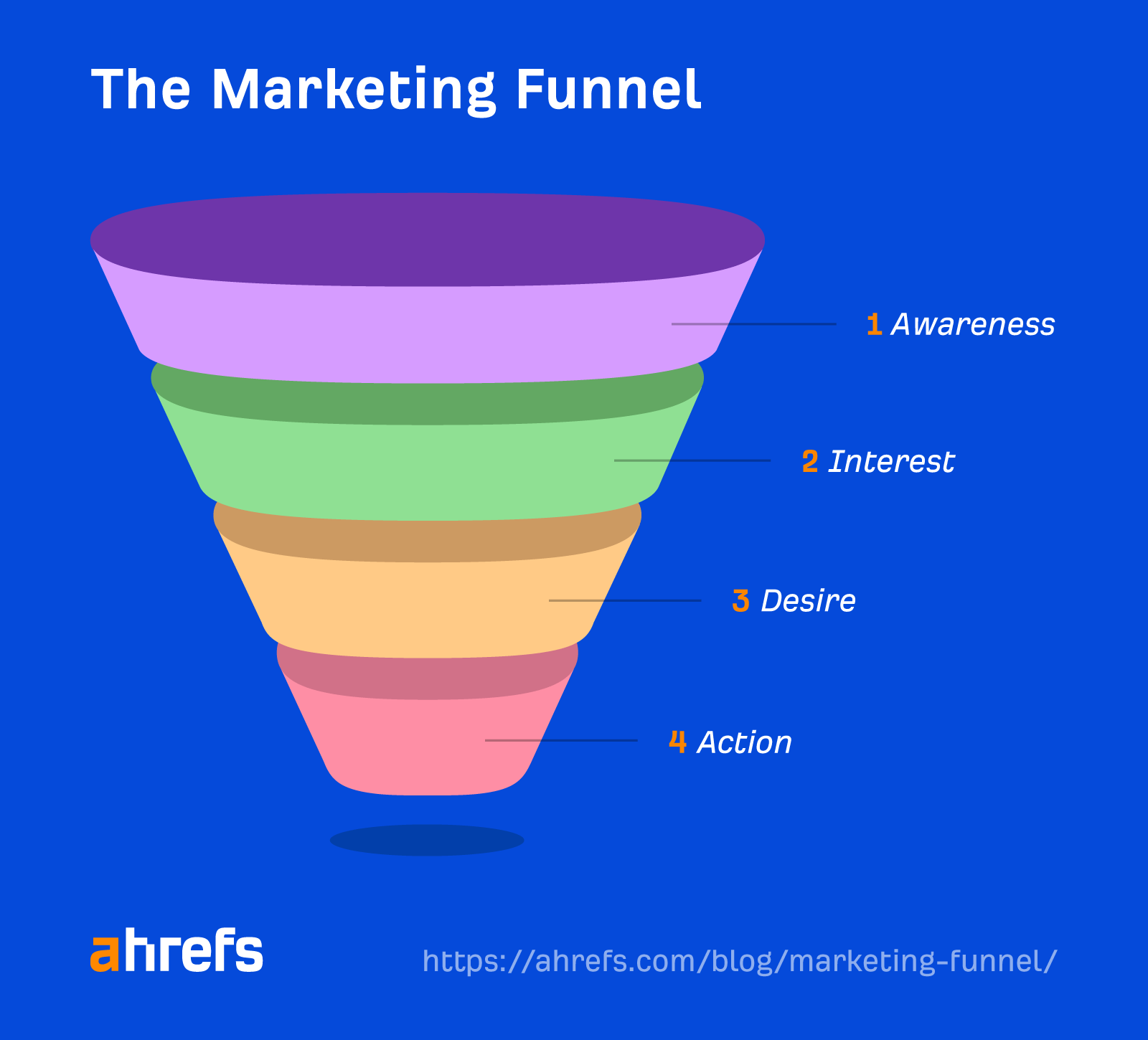
People naturally drop out at each stage because not everyone who knows your brand will become a customer. This creates the funnel shape.
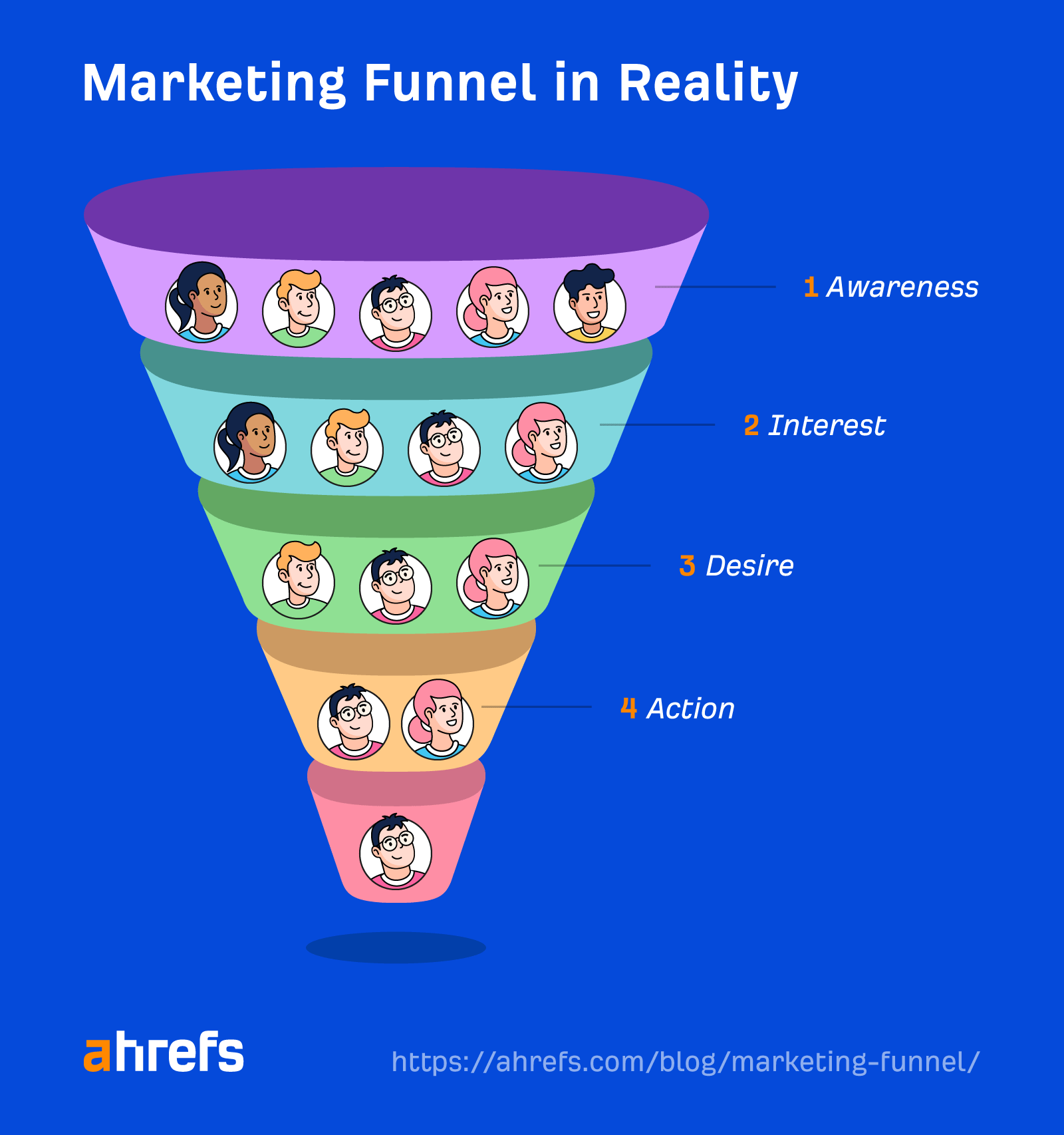
The marketing funnel is based on the Awareness-Interest-Desire-Action (AIDA) model, first developed in 1898 by E. St. Elmo Lewis, an advertising advocate.
- Awareness – When someone becomes aware of your brand, product, or service.
- Interest – When someone expresses interest in your product or service.
- Desire – When someone evaluates your product or service. This stage is also known as “Consideration.”
- Action – When someone becomes a customer. This stage is also known as “Conversion.”
Let’s take a closer look at each stage of the funnel.
1. Awareness
The Awareness stage is when people first learn about your brand.
For example, they may be searching for something on YouTube, chance upon your video, and watch it:
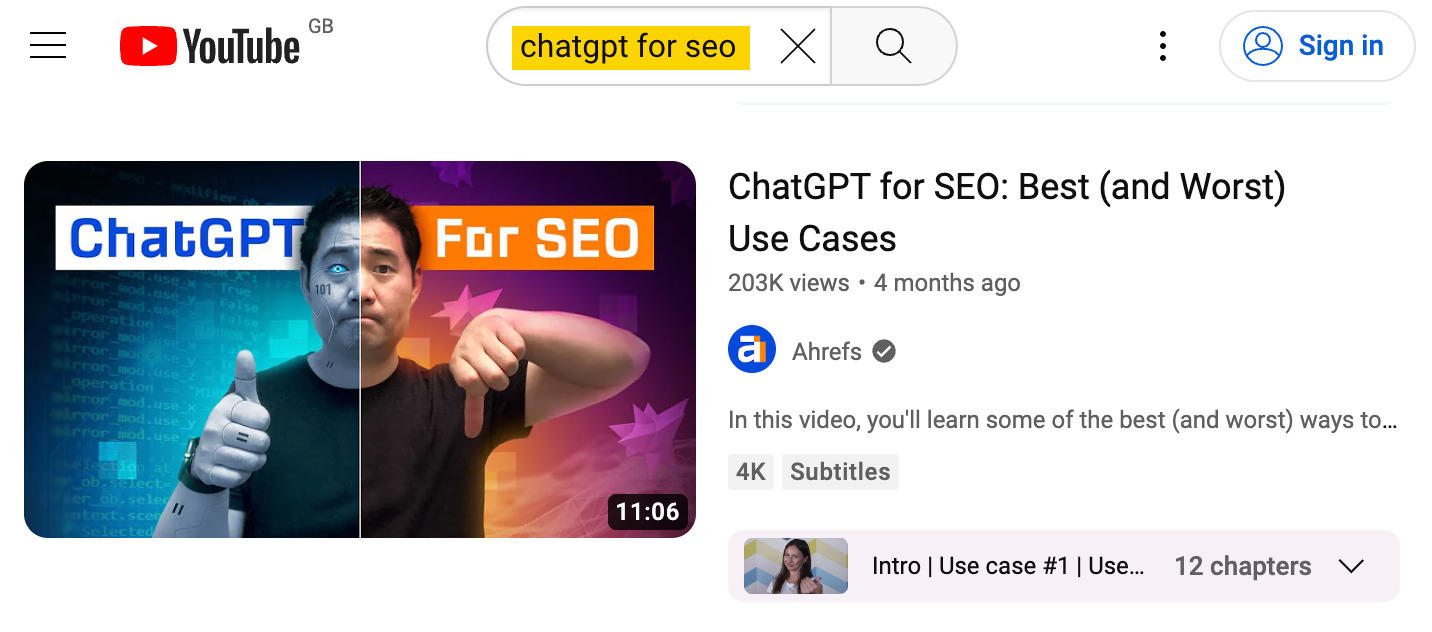
They now know you exist.
2. Interest
The Interest stage is when people start to engage with your brand.
For example, they may watch a few more of your videos, subscribe to your YouTube channel, browse your website, and even sign up to your email list.
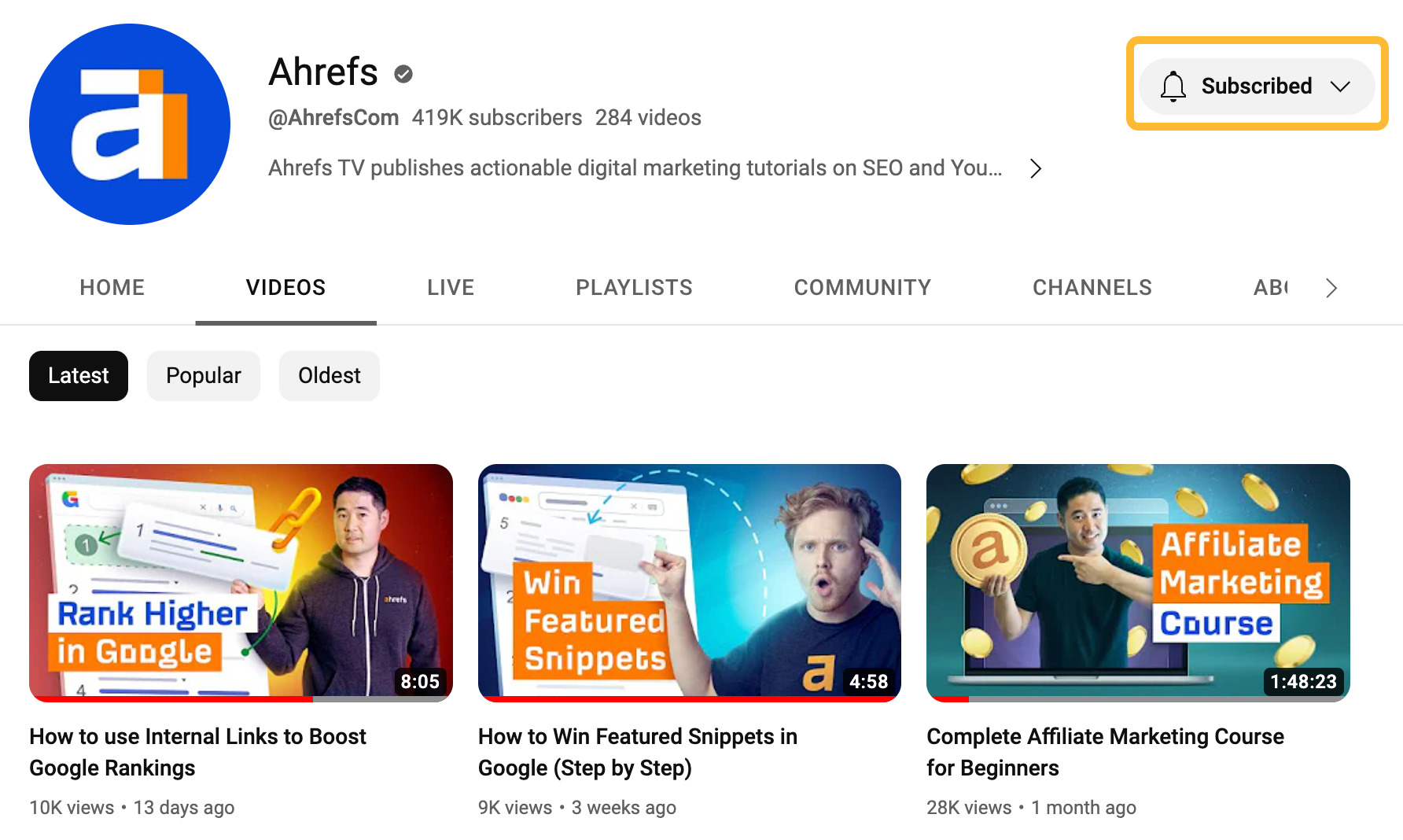
They now know what you do or sell and are interested in it.
3. Desire
The Desire stage (also known as Consideration) is when people evaluate your product or service.
Just because they know who you are and what you do doesn’t mean you’re their final choice. They’ll evaluate alternatives, read reviews, talk to friends and family, and compare.
For example, Ahrefs estimates hundreds of monthly searches for Talisker whiskey reviews:

4. Action
The Action stage is when people have decided they’re going to buy from you.
You’re the chosen one. They’ve added your product to the cart.
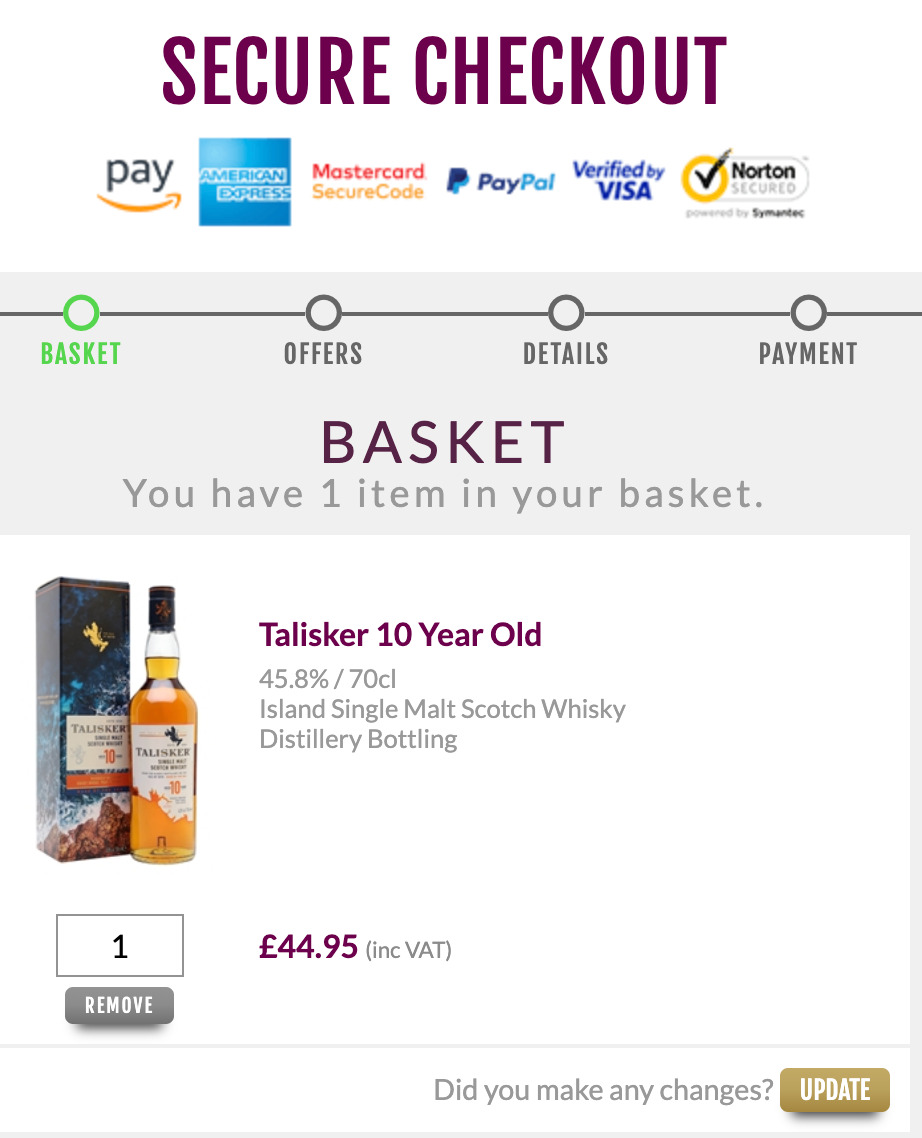
Your goal is to make it easy for them to take action and click “buy.”
In the real world, people don’t follow the funnel linearly. They may bounce back and forth, stay in one stage without progressing, and more.
It would be impossible for any marketing team to plan for the infinite variations that could occur.
Therefore, the marketing funnel simplifies the customer journey and serves as a mental model for businesses to tweak their marketing. You’ll be able to ensure you’re executing marketing tactics at each stage.
Without this intentional focus, some stages of your marketing funnel will get neglected and you’ll end up with “holes” that cause more people to drop out than necessary (i.e., a “leaky” funnel).
For example, you could be driving a lot of traffic to your website; yet none of those people are signing up for your email list. The marketing funnel can help bring awareness to this issue, allowing you to fix it.
Every business has a customer journey and, therefore, a marketing funnel. So in theory, you can’t “create” a marketing funnel—you can only tweak and improve it.
Practically speaking, “creating” a marketing funnel means executing marketing activities at each stage. To make implementation easier, many marketers further simplify the funnel into three stages:
- Top of the funnel (TOFU) – Awareness.
- Middle of the funnel (MOFU) – Interest.
- Bottom of the funnel (BOFU) – Desire and Action.
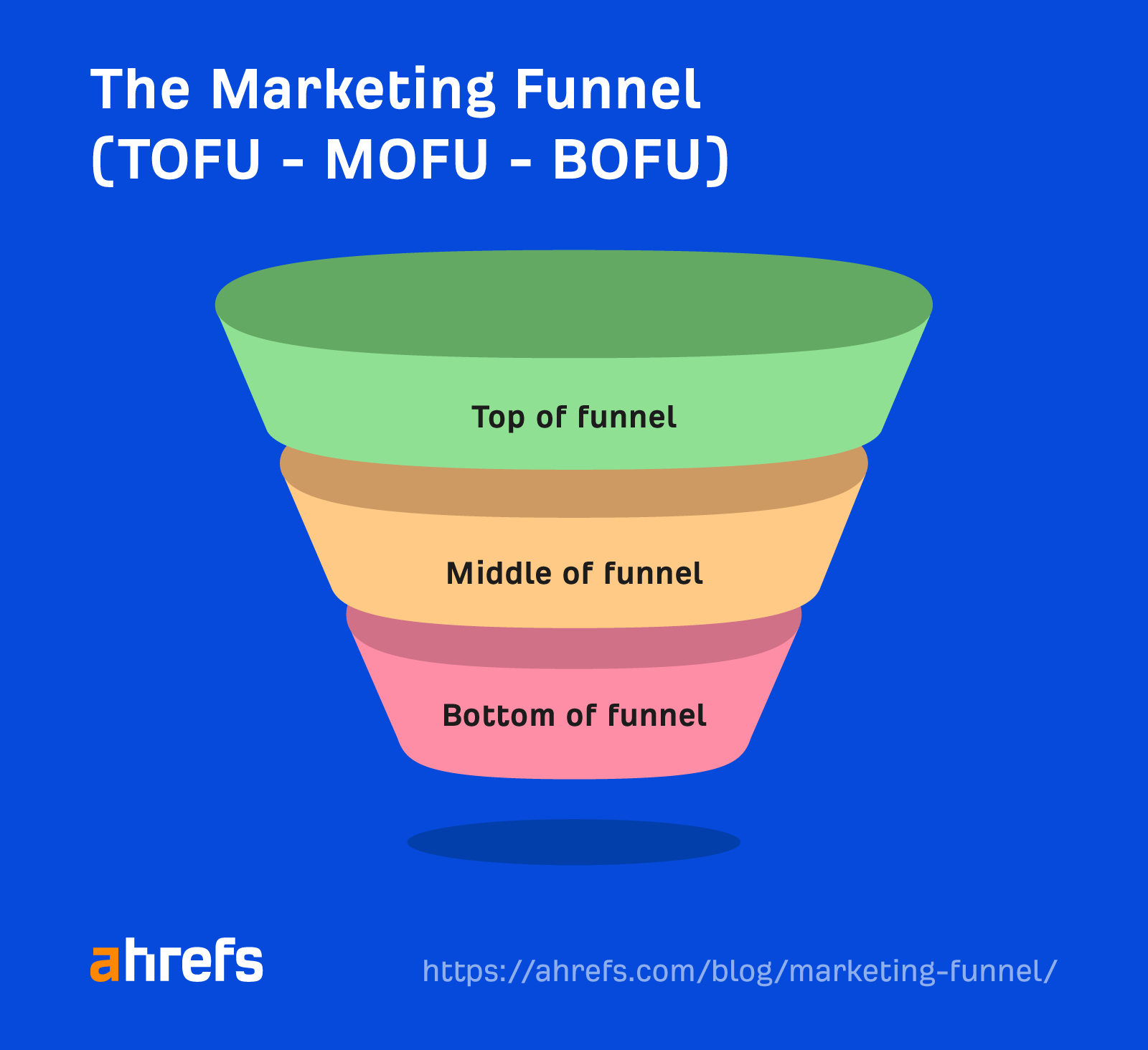
Here are the tactics you can implement in each stage:
1. Top of funnel (TOFU)
The top of the funnel is the Awareness stage. Your goal is to “open up the funnel,” i.e., introduce your brand to as many relevant people as possible.
Here are some tactics to do that:
Target TOFU keywords
Your prospects are almost certainly searching for information related to what you sell on Google. So you’ll want your website to be visible in the search results.
In the Awareness stage, you’ll want to create content targeting keywords that your target customers are likely to be searching for early in their journey.
For example, here’s how a potential customer’s journey for Ahrefs—an all-in-one search engine optimization (SEO) toolset—may look like:
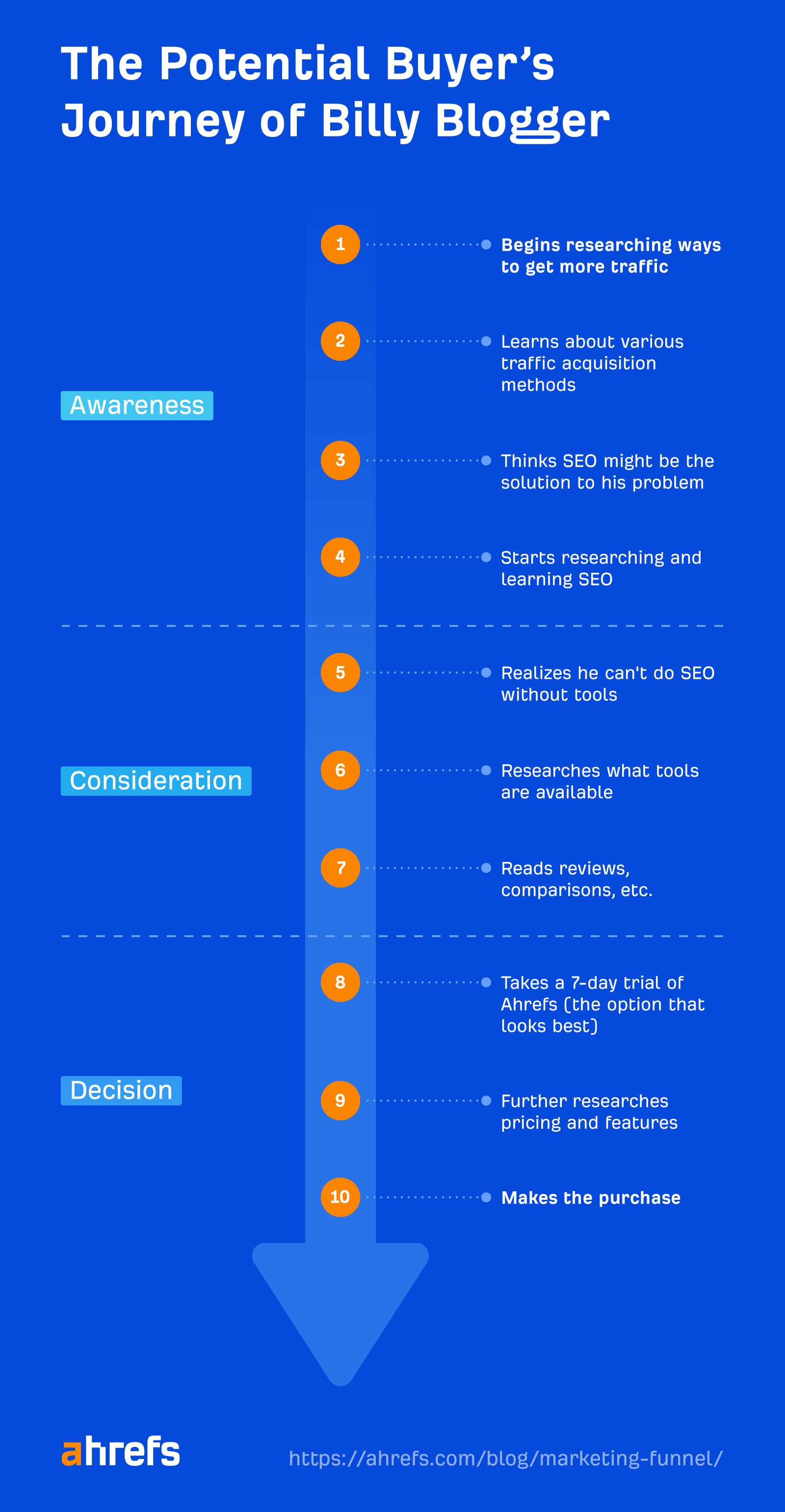
As you can see, people in the Awareness stage don’t know we exist. In fact, they may not even know SEO is the solution to their problem. Instead, they may be searching for something broader, like how to get traffic to their website.
So by targeting these keywords, we can introduce searchers to SEO and, therefore, our brand.
How do you find TOFU keywords? Here’s how:
- Go to Ahrefs’ Keywords Explorer
- Enter top-of-the-funnel terms (for Ahrefs, it’ll be keywords like “blog traffic” and “website traffic”)
- Go to the Matching terms report
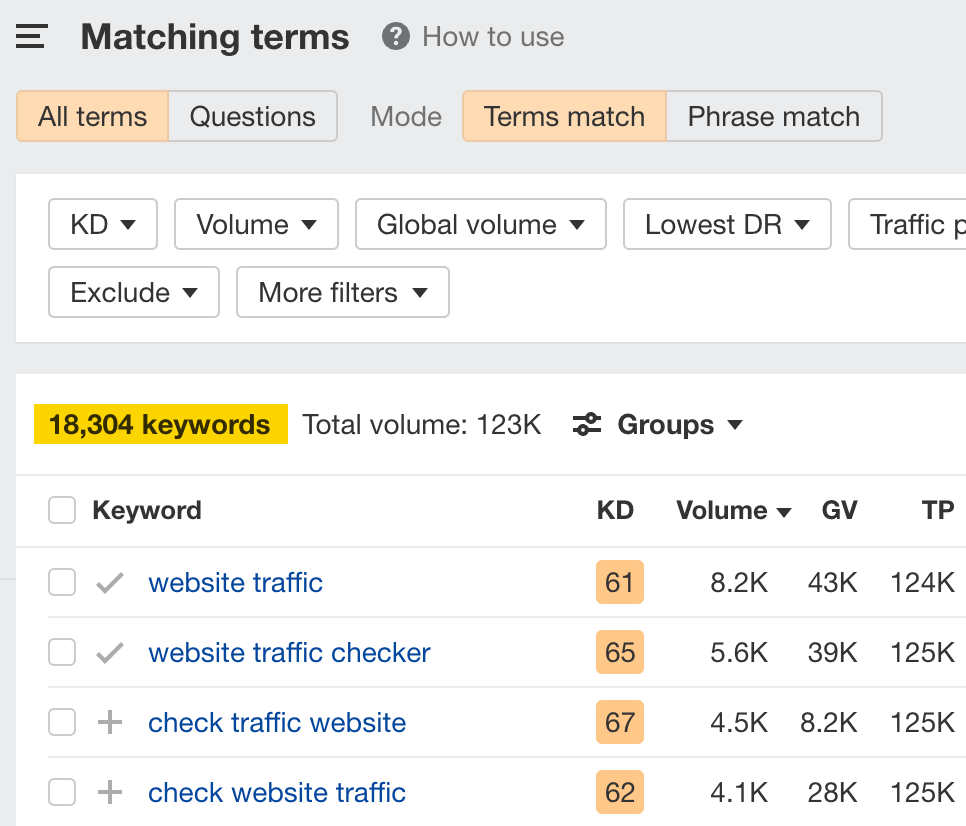
From here, you’ll want to go through the list to find keywords that are relevant to your site. For example, we can likely target this keyword for Ahrefs:

Tap into other people’s audiences
Some people in your industry have built a large audience of loyal readers, listeners, and viewers. You can leverage that and expose your brand to a new group of people.
For example, our chief marketing officer, Tim Soulo, appears on podcasts frequently:
Here’s how you can find potential podcast opportunities:
- Find a prolific podcast guest in your industry
- Go to Ahrefs’ Site Explorer
- Enter their domain
- Go to the Backlinks report
- In the “Referring page title” filter, look for “episode”
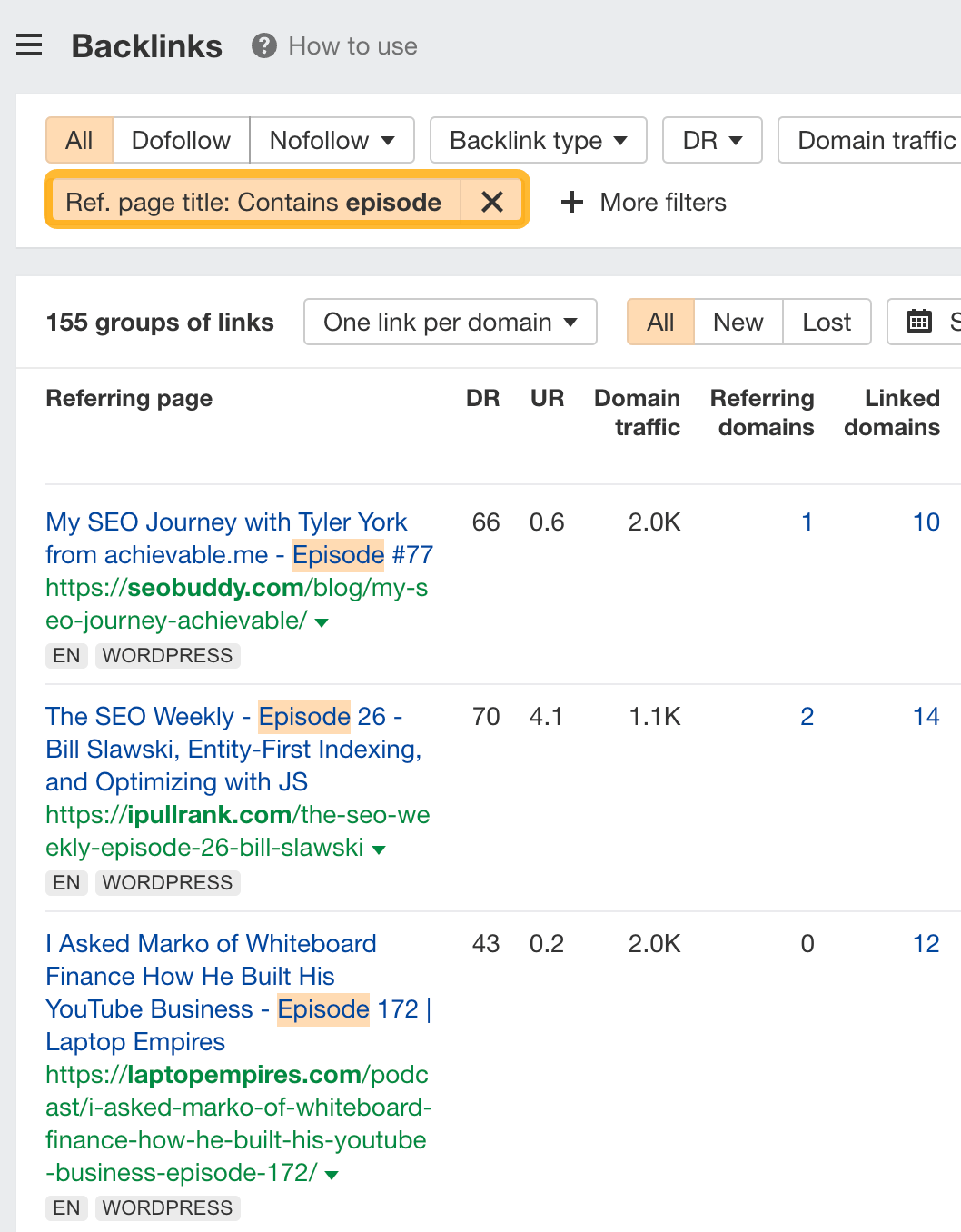
Podcast appearances aren’t the only way. You can appear on a webinar, present at a conference, write a guest post, or co-create content.
Ads
Whether it’s YouTube ads or sponsorships, thousands of brands have been built using ads.
It’s one of the most tried and tested tactics for building brand awareness.
If you have the budget, it’s a great way to generate eyeballs for your brand.
2. Middle of funnel (MOFU)
The middle of the funnel is the Interest stage. Your goal is to capture their interest, nurture it, and convince them you’re the right product for the job.
Here are some tactics to do that:
Target MOFU keywords
In this stage, our target customer knows what SEO is. They also know they need an SEO tool.
So creating content for the middle of the funnel means we’re targeting topics related to:
- SEO tools.
- Tools for each aspect of SEO (e.g., keyword research tools, link building tools).
- Free versions of tools (e.g., free backlink checker).
Here’s how to find these topics:
- Go to Ahrefs’ Keywords Explorer
- Enter MOFU terms (for example, “seo,” “backlink,” “keyword”)
- Go to the Matching terms report
- In the “Include” filter, add terms like “tool,” “tools,” “checker,” “calculator”

Look through the list and pick out relevant keywords.
Get them to sign up for your email list
Someone can indicate their interest in your brand in various ways. However, they’re not made equal—there’s a hierarchy of value for each platform:
What do you think the conversion rate is between followers on different platforms?
Like I think a Twitter follower is more valuable than an Instagram follower, which is more valuable than a Facebook follower… but what’s the ratio? Where does TikTok rank?
— Nat Eliason (@nateliason) December 6, 2020
Email is the highest value “interest indication.” It’s explicit permission from someone to enter their inbox.
You’ll want to make sure your website visitors are signing up for your email list. Use calls to action to encourage them to subscribe. For example, we have a floating sign-up box beside every blog post for our newsletter:

You can add incentives to sweeten the deal, like what Intercom does:

Don’t forget to create a “welcome” sequence to introduce your brand, product, service, or content after they sign up. For example, someone signing up for our newsletter will receive a “welcome” email introducing our best blog content:
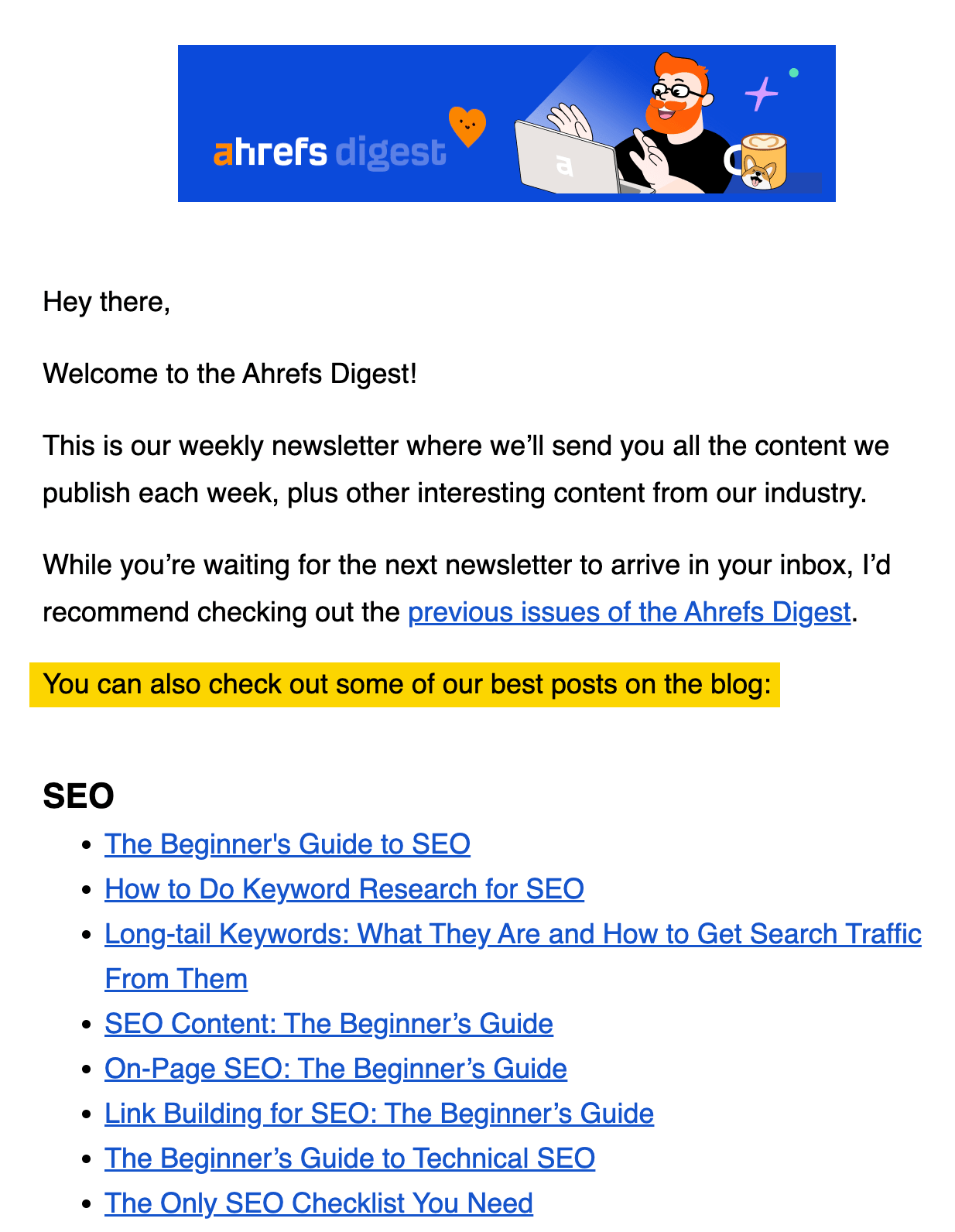
Get more reviews
According to PowerReviews’ 2023 survey:
- 93% of shoppers say ratings and reviews impact whether or not they purchase a product.
- 91% of people always read reviews.
- 45% of consumers won’t purchase a product if there are no reviews available for it.
Make no mistake: Reviews are important. So you’ll want to get more reviews on popular review platforms in your niche. That could be Google Reviews, TrustPilot or, in the software world, G2:

The best way to get high ratings is to create a great product and deliver an amazing experience for your customers.
However, even highly satisfied customers may not remember to leave reviews, so you’ll want to ask for one when the opportunity arises. For example, a good moment is when they’ve used your product or service (e.g., Airbnb asks for reviews when you’ve finished your stay).
Finally, whether good or bad, you’ll want to respond to these reviews. A Harvard Business Review study found that replying to reviews results in better overall ratings.
My colleague, Andrei Țiț, replies to all our reviews:

Teach them how to use your product
Tim once said:
My theory is that people don’t sign up for your product and then learn how to use it. It’s the opposite, in fact. They first learn how to use your product, and they sign up because they already know how to use it.
Use your content to guide people into visualizing how to use your product in their daily and work lives. If they see your product in action, they can imagine themselves using it.
For example, our YouTube videos and articles feature our toolset prominently. We even have multiple free, full-length courses that show you how to solve SEO problems with our toolset:
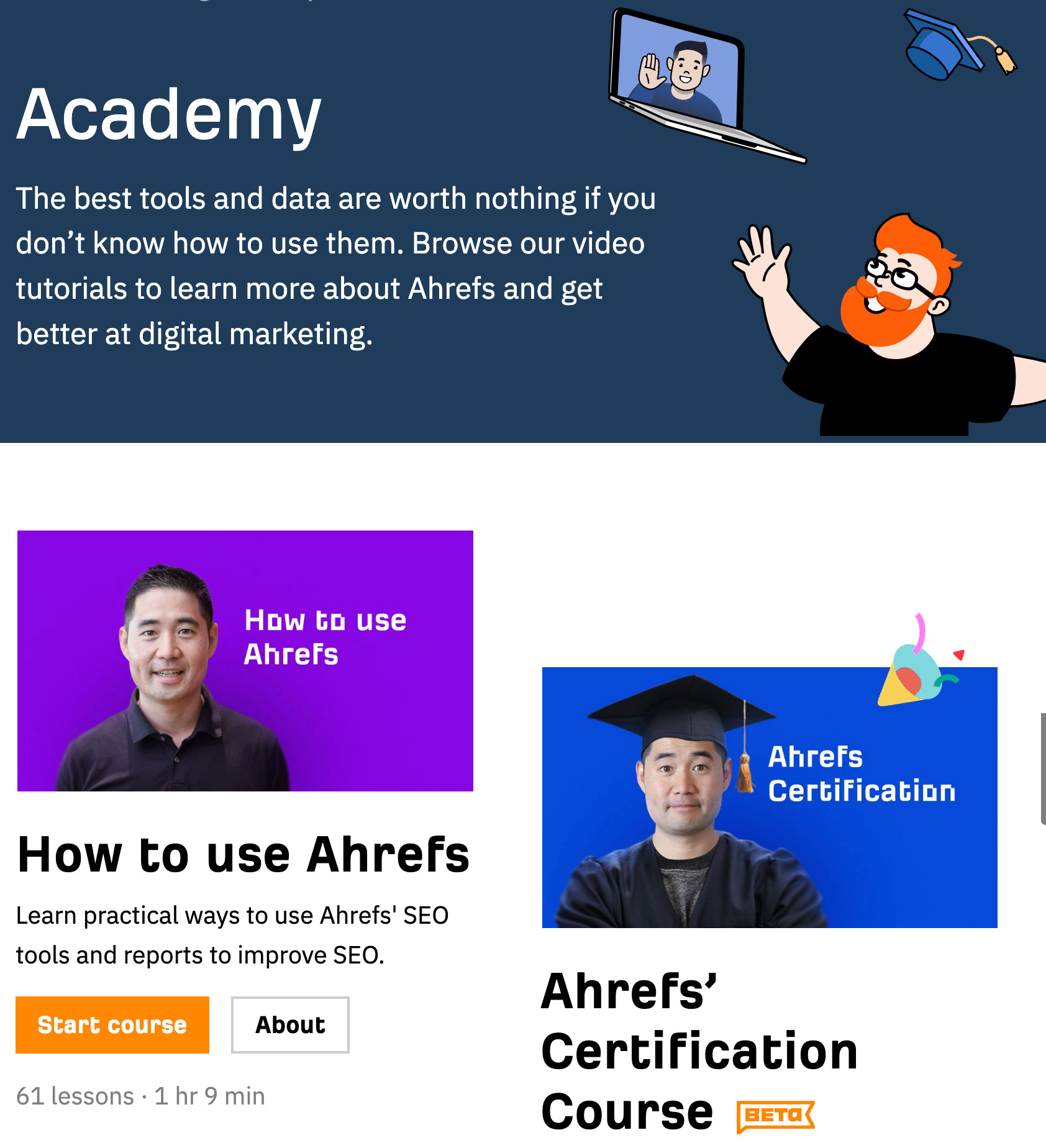
Offer a free version of your product
Seeing is believing. But using the product will imprint it on your customers’ minds. That’s why food companies offer free samples—one taste, and you’ll know if you’ll buy it.
At Ahrefs, we offer free versions of our toolset:
When potential customers consume our content and are able to follow along with our free tools, we’ll be top of their minds when they decide to purchase in the future.
3. Bottom of funnel (BOFU)
The bottom of the funnel consists of both the Desire and Action stages. Your goal is to:
- Convince potential customers to choose you.
- Get them to buy now.
Here are some tactics to do that:
Target BOFU keywords
In this stage, people are evaluating. They’re comparing, asking friends and family, and reading reviews.
So creating content for this stage means targeting comparison-type keywords. Here’s how to find them:
- Go to Ahrefs’ Keywords Explorer
- Enter your brand and/or your competitors’ brands
- Go to the Matching terms report
- In the “Include” filter, add words like “vs, versus, review, reviews”

Create a comparison page
Your potential customers will compare all possible solutions. You can take control of the narrative by creating a comparison page.

Typically, most companies will create a side-by-side comparison where they “conveniently” win. We disliked that standard practice, so we decided to do something new: feature third-party reviews and polls and discuss the features only our toolset has.
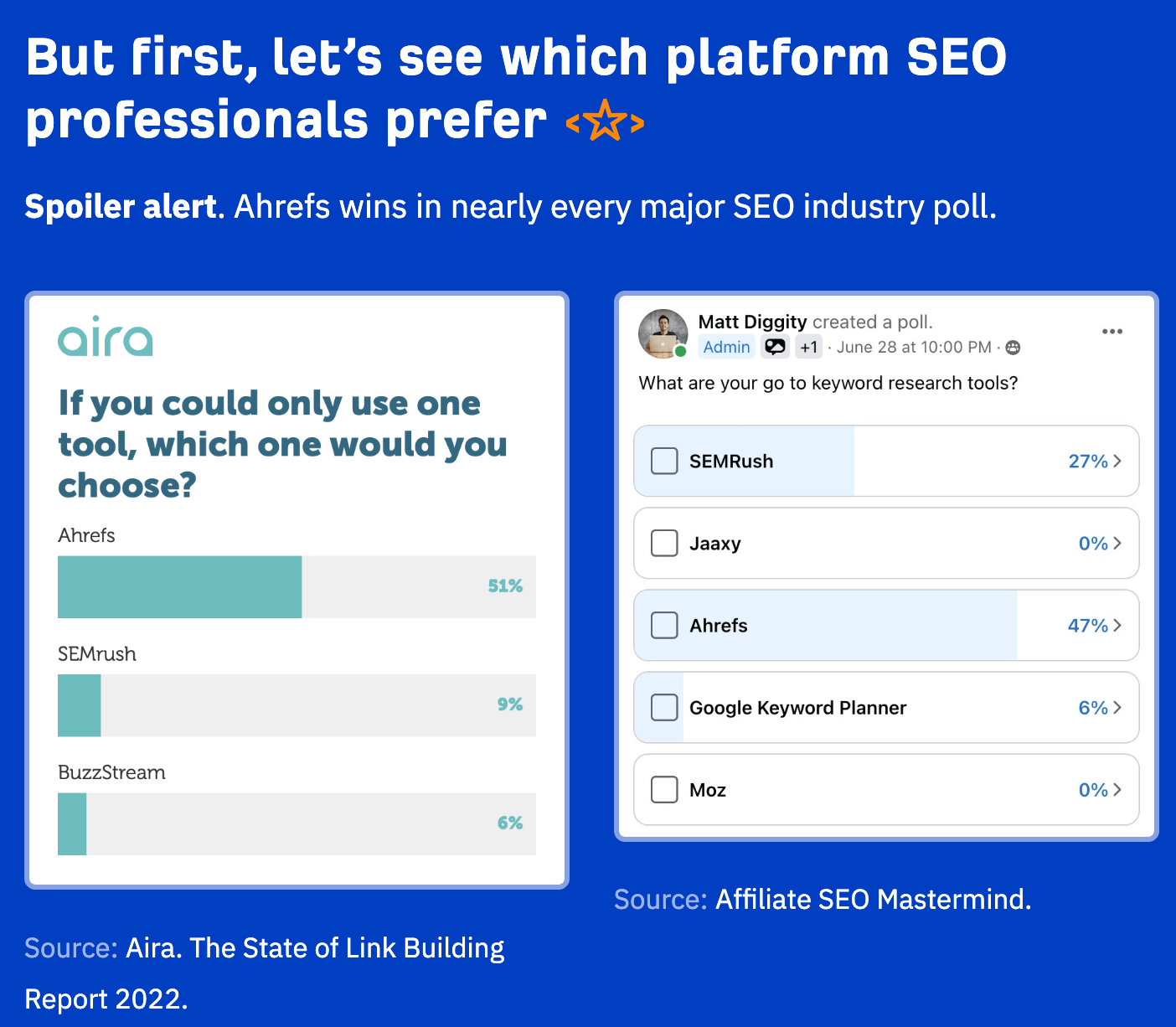

Address their final objections
Talk to your customer support, sales team, and account managers. Figure out what’s stopping people from buying. You’ll want to create content that addresses each and every one of their objections.
Give people a final “nudge”
Provide them with a compelling reason to buy right now.
A common tactic is to utilize urgency. For example, Booking.com tells you if there is only one room left:

So if your cohort-based course is closing or a product is going out of stock soon, give potential customers a heads-up.
A word of caution: Don’t fake this. You will lose your customers’ trust.
As you build your funnel, you should assign metrics to each stage. This can help you improve the funnel and fix “leaky” funnel issues. The exact metric to measure will depend on your strategy, but here are some ideas:
| Metric | Description | |
|---|---|---|
| Top of funnel (TOFU) | Users | The number of unique visitors your website receives. |
| Organic traffic | The number of clicks coming from search engines to your website (e.g., Google). | |
| Keyword rankings (TOFU) | Your website’s organic ranking positions in the search results for TOFU keywords. | |
| Middle of funnel (MOFU) | Star ratings | The quantity and quality of reviews on different platforms like Google Reviews. |
| Monthly subscriber growth rate | The percentage difference between the number of email subscribers from the start of one month to the next. | |
| Keyword rankings (MOFU) | Your website’s organic ranking positions in the search results for MOFU keywords. | |
| Bottom of funnel (BOFU) | Conversions | A conversion happens when a visitor to your website completes an action that you are tracking (e.g., buy your product). |
| Return on investment (ROI) | The measure of the impact a campaign or channel had on the revenue of the business (e.g., Facebook ads). | |
| Keyword rankings (BOFU) | Your website’s organic ranking positions in the search results for BOFU keywords. |
You can track most of these metrics via tools like Google Analytics, Google Search Console, and Ahrefs.
Some frequently asked questions about marketing funnels.
What is the difference between a B2B and B2C marketing funnel?
The difference is that, in B2C, customers usually navigate the funnel alone. In B2B, more decision-makers are involved, so more people navigate the funnel.
As a result, the marketing tactics used in each stage will be different. For example, in B2B, the Desire or Action stage may heavily involve salespeople, but this will be unlikely in B2C.
Is there a difference between a marketing and sales funnel?
They’re the same, just terms used interchangeably.
However, there may be differences in how responsibilities are split between marketing and sales teams. For example, traditionally, marketing teams were in charge of the top of the funnel, whereas sales teams were in charge of the bottom of the funnel (with MOFU split between both).
What about loyalty and advocacy?
Some marketers have found the existing model to be incomplete because it focuses solely on converting a prospect into a customer. After all, conventional marketing wisdom states that it’s cheaper to retain customers than to acquire new ones.
So two more stages are added to the funnel:
- Loyalty – The customer repeatedly buys from you.
- Advocacy – The customer recommends your brand to other people.
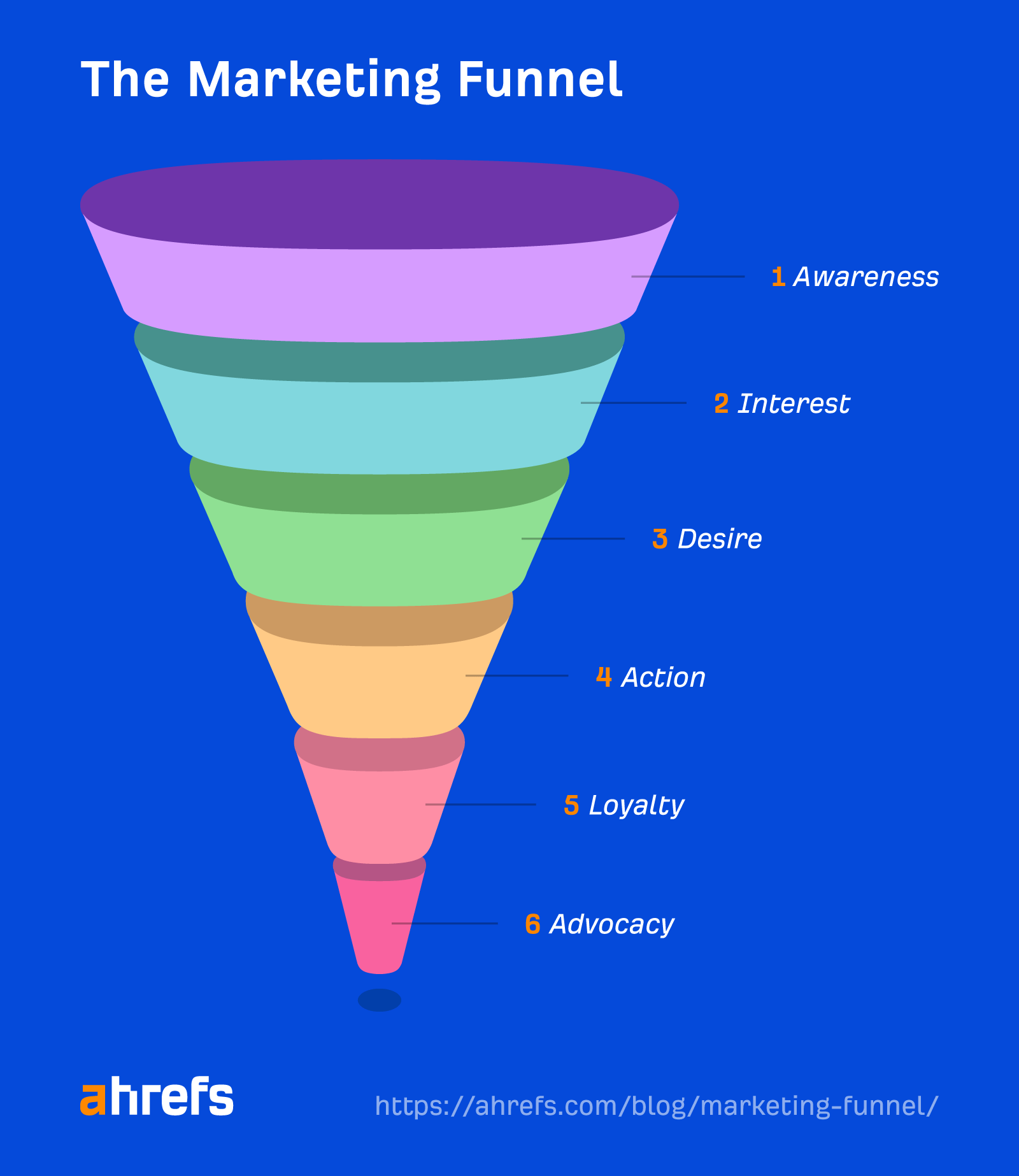
Examples of tactics for these two stages are:
- Loyalty – At Ahrefs, we have a customers-only community where our customers can hang out, ask questions, and provide feedback on our toolset.
- Advocacy – Consider setting up a referral program so it’s easier for your customers to refer your product to their friends.
Final thoughts
The funnel provides a model for you to analyze and improve your marketing.
Tweaking it is a never-ending process. But that’s the fun part of marketing. Keep on experimenting, and you’ll find ways to improve your results.
Any questions or comments? Let me know on Twitter or Threads.


